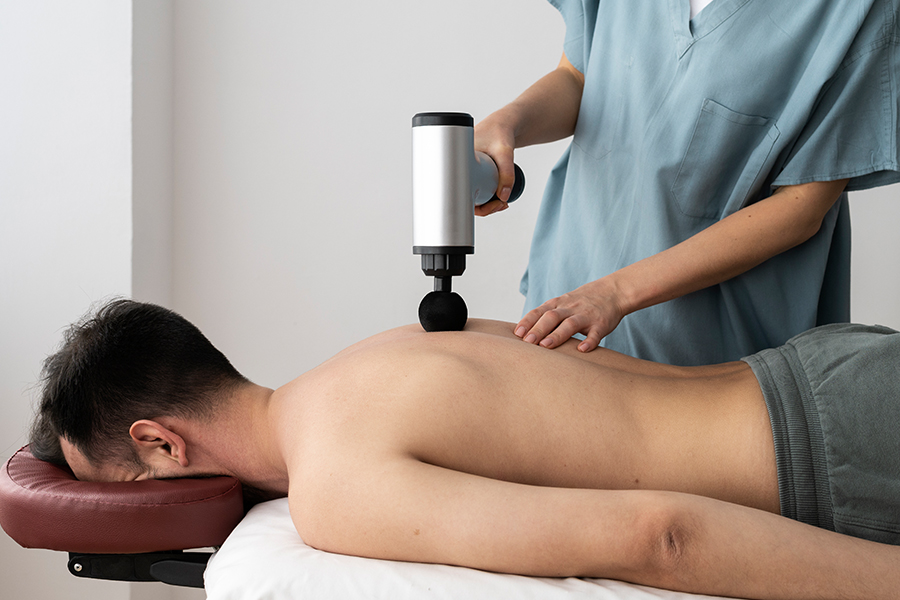Indulging in providing Neuromuscular Therapy in Atlanta, we have seen millions of Americans suffering from chronic back pain. If you are among them, you know how profoundly it can impact your quality of life. From limiting your daily activities to affecting your sleep and mood, persistent back pain can be both physically and emotionally draining. While many treatment options exist, neuromuscular therapy (NMT) has emerged as a particularly effective approach for addressing the root causes of chronic back pain rather than just masking symptoms.
What refers to Chronic Back Pain?
Chronic back pain is defined as pain that persists for twelve(12) weeks or longer, even after the initial injury or underlying cause has been treated. According to Johns Hopkins Medicine, back pain is one of the most common reasons people seek medical attention and a leading cause of disability worldwide.
Common causes of chronic back pain include:
- Muscle or ligament injuries: Lifting heavy objects repeatedly or making abrupt, awkward movements can lead to overstretching or tearing of the muscles and ligaments in the back.
- Herniated or bulging discs: The inner gel-like core of a spinal disc can protrude or break through the outer layer, potentially irritating nearby nerves.
- Arthritis: Osteoarthritis can affect the lower back, causing pain and stiffness
- Skeletal irregularities: Conditions like scoliosis can lead to back pain
- Myofascial pain syndrome: Unexplained muscle pain and tenderness
What makes chronic back pain particularly challenging is that it often involves complex interactions between physical, psychological, and social factors. This complexity is why comprehensive approaches like neuromuscular therapy can be especially beneficial.
What is Neuromuscular Therapy?
Neuromuscular therapy is a specialized form of manual therapy that addresses dysfunction in the soft tissues of the body—muscles, tendons, ligaments, and fascia. It goes beyond traditional massage by incorporating detailed assessment and specific treatment techniques aimed at correcting imbalances in the neuromuscular system.
The therapy is based on the understanding that when muscles develop trigger points (hyperirritable spots), adhesions, or chronic tension patterns, they can refer pain to other areas of the body and create compensatory patterns that further perpetuate pain cycles.
Key Principles of Neuromuscular Massage Therapy
- Precision treatment of trigger points: Identifying and treating specific points in muscles that refer pain to other areas
- Attention to Ischemia: Addressing reduced blood flow to tissues that contribute to pain and dysfunction
- Neural entrapment assessment: Identifying where nerves may be compressed by muscles or other structures
- Postural analysis: Examining how structural imbalances contribute to muscle dysfunction
- Biomechanical assessment: Analyzing movement patterns that may perpetuate pain
How Neuromuscular Therapy Works – Neuromuscular Therapy Techniques

This addresses chronic back pain through several neuromuscular therapy techniques:
1. Identifying and Treating Trigger Points
Trigger points are highly sensitive areas within skeletal muscles, often felt as small knots or nodules within tight bands of muscle fibers. When compressed, these points can produce referred pain in predictable patterns.
For example, trigger points in the quadratus lumborum muscle (a deep back muscle) can refer to pain in the lower back, hip, and buttocks. By applying specific pressure techniques to these trigger points, a neuromuscular therapist can help release the chronic contraction and alleviate pain.
Research published in the Journal of Bodywork and Movement Therapies has shown that trigger point therapy can significantly reduce pain intensity and improve function in patients with chronic low back pain.
2. Improving Circulation and Reducing Ischemia
Chronic muscle tension restricts blood flow to tissues, creating Ischemia (reduced blood supply) that leads to the accumulation of metabolic waste products and contributes to pain. Neuromuscular therapy techniques help restore proper circulation, allowing for:
- Delivery of oxygen and nutrients to tissues
- Removal of metabolic waste products
- Reduction of inflammation
- Promotion of healing
3. Releasing Fascial Restrictions
Fascia is a type of connective tissue that envelops and supports muscles, muscle groups, blood vessels, and nerves throughout the body. When fascia becomes restricted due to injury, poor posture, or chronic tension, it can create pulling patterns that contribute to pain and limited mobility.
Neuromuscular massage therapy incorporates myofascial release techniques that help restore normal fascial mobility, allowing muscles to function more efficiently and reducing strain on the back.
4. Correcting Postural Imbalances
Poor posture is both a cause and result of chronic back pain. Neuromuscular therapists assess postural patterns and work to release the chronically tight muscles while also guiding the strengthening of weak muscles to create a better balance.
For example, many people with chronic back pain have an anterior pelvic tilt pattern, with tight hip flexors and weak abdominals. A neuromuscular approach would include releasing the tight hip flexors and psoas muscles while providing exercises to strengthen the core.
5. Addressing Nerve Compression
When muscles are chronically tight, they can compress nerves, leading to pain, tingling, or numbness. Neuromuscular therapy techniques can release the muscles that are compressing nerves, providing relief from these symptoms.
For instance, piriformis syndrome occurs when the piriformis muscle compresses the sciatic nerve, causing pain that radiates down the leg. Neuromuscular therapy massage can effectively release the piriformis muscle, reducing pressure on the sciatic nerve.
The Neuromuscular Therapy Session Experience
If you’re considering neuromuscular therapy for your chronic back pain, here’s what you can expect during a typical session:
1. Comprehensive Assessment
Your first session will likely include:
- Detailed health history
- Postural analysis
- Range of motion testing
- Gait assessment
- Using palpation techniques to examine muscles
2. Targeted Treatment
Based on the assessment findings, the therapist will develop a treatment plan that may include:
- Specific pressure techniques for trigger points
- Myofascial release
- Muscle energy techniques
- Stretching
- Joint mobilization
- Corrective exercise instruction
3. Active Client Participation
Unlike some passive therapies, neuromuscular therapy massage often involves active participation from the client, such as:
- Deep breathing during trigger point work
- Performing specific movements during treatment
- Providing feedback about pain referral patterns
- Learning and practicing corrective exercises
4. Education and Self-Care
A crucial component of neuromuscular therapy is education about:
- Postural awareness
- Ergonomic modifications
- Self-care techniques
- Home exercise programs
- Movement patterns that help or hinder recovery
Who Can Benefit from Neuromuscular Therapy?

As we provide Neuromuscular therapy in Atlanta, we have seen that it can be particularly beneficial for people with:
- Chronic back pain that hasn’t been treated with other treatments
- Pain related to postural issues (such as from desk work)
- Sports-related back injuries
- Back pain associated with specific activities
- Recurrent back pain that comes and goes
- Back pain with muscle spasms
However, neuromuscular therapy may not be appropriate for everyone. It’s generally not recommended for people with:
- Acute inflammation or infection
- Certain types of cancer
- Advanced osteoporosis
- Blood clotting disorders
- Certain skin conditions in the treatment area
Finding a Qualified Neuromuscular Therapist
To get the most benefit from neuromuscular therapy, it’s important to work with a qualified practitioner. Look for someone who:
- Has specific training in neuromuscular therapy techniques
- Holds certification from a recognized organization
- Has experience treating chronic back pain
- Takes a thorough history and performs a comprehensive assessment
- Provides education and self-care recommendations
- Communicate clearly about treatment plans and expected outcomes.
If you’re seeking effective neuromuscular therapy in Atlanta, Conscious Medicine stands out as a top destination. With a team of skilled professionals dedicated to personalized care, we combine advanced techniques with a holistic approach to relieve pain, improve mobility, and restore balance in the body.
A Targeted Approach for Lasting Relief
Chronic back pain doesn’t have to be a life sentence. Neuromuscular therapy offers a sophisticated, targeted approach that addresses the root causes of back pain rather than just temporarily masking symptoms.
By identifying and treating specific muscle dysfunction, improving circulation, releasing fascial restrictions, correcting postural imbalances, and addressing nerve compression, neuromuscular therapy provides a comprehensive solution for many people suffering from chronic back pain.
If you’ve been struggling with persistent back pain that hasn’t responded to other treatments, neuromuscular therapy may be worth exploring as part of your pain management strategy. You can consult with our practitioners at Conscious Medicine to determine if this approach is appropriate for your specific condition. To give you the best Neuromuscular Therapy in Atlanta, we develop an integrated treatment plan that addresses all aspects of our patients and provides a longlasting relief to them.
FAQ’s
How effective is neuromuscular therapy?
Neuromuscular therapy is highly effective for relieving muscle pain, tension, and improving circulation. It focuses on identifying and releasing trigger points in muscles, providing significant pain relief and promoting relaxation, often after just a few sessions.
What’s the best treatment for chronic back pain?
The best treatment for chronic back pain depends on the cause, but common options include physical therapy, neuromuscular therapy, chiropractic care, massage, and medications. A combination of treatments tailored to the individual often provides the best results.
What are the techniques of neuromuscular therapy?
Neuromuscular therapy includes techniques like trigger point therapy (releasing muscle knots), myofascial release (stretching connective tissue), ischemic compression (applying pressure to painful areas), and postural correction. These techniques help relieve muscle tension and improve movement.
What are the primary treatment techniques used in neuromuscular therapy?
The primary techniques in neuromuscular therapy are trigger point therapy, deep tissue massage, myofascial release, and ischemic compression. These methods aim to relieve pain, release muscle knots, and restore flexibility and function.
Is neuromuscular therapy the same as physiotherapy?
No, neuromuscular therapy focuses specifically on treating muscle pain and tension through manual techniques, while physiotherapy covers a wider range of treatments for movement disorders, rehabilitation, and injury recovery.
What are the new techniques in neuro physiotherapy?
Recent advancements in neuro physiotherapy include neuroplasticity-based therapies (brain rewiring), robotic-assisted rehabilitation, virtual reality therapy, functional electrical stimulation (FES), and mirror therapy, all aimed at improving movement and motor skills in patients with neurological conditions.
